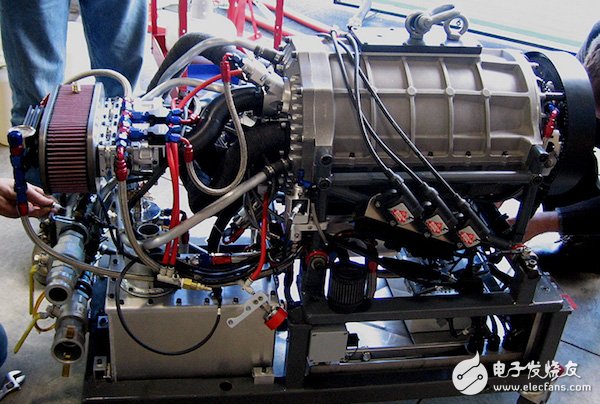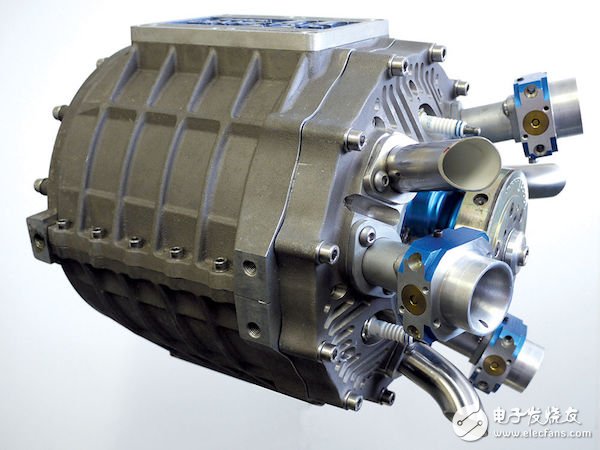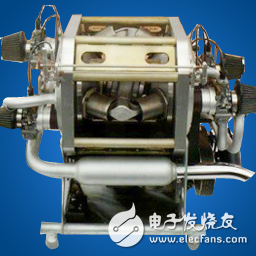Since the industrial revolution, the engine has always played a very important role, not limited to the automotive industry. Outside the automotive industry, a variety of different application scenarios and needs also make the engine have a variety of changes. There are some novel changes compared to the well-regulated engines on the car.
For example, this engine to be introduced today is one of them. This engine is similar to the engine used in today's vehicles. It is also a piston engine that follows the intake-compression-combustion-exhaust cycle. The biggest difference is that the cylinder is not in-line, V-shaped or horizontally opposed, but rather surrounds the output. The shaft is distributed in a circle around the output shaft. That is to say, the piston is parallel to the output shaft, and thus is called an Axial Engine. It is also called a cylindrical engine (Barrel Engine) according to its shape, or a Z-type crankshaft engine according to the crankshaft style. Z-crank Engine).

Duke third generation axial engine
The advantage lies in lightweight, high output performanceIn 1911, the world's first axial engine was sold by the Macomber Rotary Engine Company in the United States. The engine was built by another company, the Avis Engine Company, with seven cylinders arranged around the output shaft. At that time, because the cylinder was rotating, it was also called a rotating engine.
Since then, almost all of the engine companies that manufacture or sell this engine company are basically in the aviation industry and are used on airplanes. Now, the most common application scenario for this type of engine is above the torpedo as its propeller.
The only one trying to port it to the automotive industry is Duke, a New Zealand engine company. The company began developing axial engines in 1993 and carried out several iterations and optimizations. In 1999, an axial engine was installed on the vehicle for testing. Subsequently, Duke teamed up with engine parts supplier Mahler to test its engines at MAHLE's US and UK test sites.
Duke named the engine Duke Engine, the Duke engine. First of all, from the Duke engine, how does the cylinder form a circular distribution around the output shaft?
The Duke engine is very different from the piston engine on the current car. The piston does not only reciprocate up and down, but also rotates around the output shaft. The link mechanism connected to the piston pushes the lower profiled crankshaft to rotate in the opposite direction to the cylinder, so that the final output shaft also rotates in the opposite direction to the piston.
Another difference is that the axial engine is not equipped with a set of intake and exhaust mechanisms and ignition mechanism for each cylinder. The exhaust port, air inlet and spark plug are also mounted on the circular fixed parts that can be regarded as cylinder heads. . The Duke engine has five cylinders and a displacement of 3 liters. There are three sets of intake and exhaust and ignition devices. When starting the engine, the cylinder will pass through the air inlet, the spark plug and the exhaust port in turn. When the corresponding position is reached, it is like the intake, ignition and exhaust phases of the piston engine that is commonly used nowadays. 3 burnings. Corresponding to the three intake and exhaust ports, there are only three intake and exhaust manifolds.
The particularity of the axial engine comes from this. First, the cylinder movement direction is opposite to the crankshaft movement direction, which can reduce the vibration of the engine. Secondly, the special arrangement of the cylinders can make the structure of the whole engine compact, and this way of intake and exhaust can also reduce many parts on the engine. Compared with the piston engines commonly used in automobiles, the camshafts are equipped with camshafts. The gas mechanism and the timing mechanism connected to the crankshaft are omitted, and the reduction in the number of parts can not only make the engine structure simple, but also reduce the complexity of the design, and also can greatly reduce the weight.

Duke second generation axial engine, cylindrical profile
In order to know the specific difference, Duke completed the test of the prototype in 2012 and compared the two displacement piston engines that had been mass-produced at the time. In comparison, the weight is about 17% lighter and the volume is one-third smaller. It should be noted that Duke did not accurately measure the volume of the engine when comparing the volume, but compared the box that just fits the engine and reached this conclusion.
Of course, there is also an advantage in the power output performance. Compared with the piston engine, the piston of the axial engine moves faster and the number of work per unit time increases. Therefore, Duke said that their 3-liter engine can Performance is equivalent to the output capacity of a traditional 3.6-liter piston engine. In this way, the engine's advantages in weight and miniaturization are more obvious.
This special arrangement also brings some additional advantages to the axial engine. For example, because the intake and exhaust valves are eliminated and the spark plug is mounted on the cylinder head, the shape of the combustion chamber is designed with greater freedom. In theory, for example, the number of cylinders does not have to be five, more or less. Duke's five-cylinder arrangement is considering space utilization.
Crucially, this type of ignition allows the combustion chamber wall to remain relatively cold when burned. As a result, the Duke engine is an engine that can use multiple fuels and can use a higher compression ratio. The Duke engine has a compression ratio of 14. On the prototype, Duke used gasoline with different octane numbers (91-98) and found that it worked well and could also use some new fuels such as biofuels and natural gas. Duke also tested the different properties of kerosene and found that it could be modified or optimized for direct use. If you want to use diesel, you need to make some modifications to the engine.
The difficulty lies in the road to commercializationIf you simply look at the power output performance, or the advantages of lightweight and miniaturization, the advantages of this engine are really coveted. This should be the reason why Duke has persisted for so long, and firmly believes that engines with such advantages will certainly be useful. However, the axial engine is not a perfect engine, it also has some difficulties to overcome.
First of all, it is the sealing problem. In Duke’s official introduction, the sealing method is similar to that of a two-stroke engine or a rotary engine. A similar technique can be adopted, but since the intake and exhaust are all related to the same contact surface, there is a place where sealing is required. Reduced. The Duke engine uses a sliding metal seal (working on the oil film). Duke did not mention the specific use of metal materials, but rather selected from the already mass-produced engines. In the prototype test in March 2012, the seal test was also carried out, and the same seal components will be used in subsequent engines and further sealing tests will be carried out in the future.
Second, it is the structural design of the crankshaft. This special-shaped crankshaft plays an important role in the engine. On the one hand, the crank and the connecting rod drive the output shaft to rotate, and on the other hand, it needs to be kept opposite to the rotation direction of the cylinder, so as to reduce the vibration. Thus the structure of the crankshaft is much more complicated than that of a piston engine.
Finally, from the overall design of the engine, seal lubrication, combustion, intake and exhaust, and ignition timing settings are not the same as conventional piston engines. From the earliest conceptual design to the prototype, Duke made a lot of changes in the design of the parts, and the subsequent optimization time required (ie, from the prototype to the vector).
Duke started to develop axial engines in 1993, and began to carry out concept trials in 1995. In 1996, the first-generation axial engine was successfully commissioned. In 1998, it was tested at the University of Auckland. The maximum speed reached 3,500 rpm. The first generation of axial engines; the second generation of product development began in 2001, the maximum speed reached 6500 rpm in 2004; the third generation of engine development began in 2005, and began to contact with Mahler in 2007, part of the test work transferred from the University of Auckland Going to Mahler, the two have officially started joint development since 2011. The current third-generation engine has a maximum output of 215 hp and a maximum output of 339 Nm at a maximum of 4,500 rpm and a maximum operating speed of 6,000 rpm.


The picture above shows the first successful engine in 1996. The picture below shows the engine tested in 1998 in Oakland.
However, in addition to technical issues, the biggest problem is commercialization. From the application of the car, there is currently no product that can be commercialized, including Duke. After completing some third-generation engine testing in 2012, Duke's official website continued to be updated for more than a year, including the idea of ​​fourth-generation products and technologies, such as increasing the variable compression ratio. However, the release of information is basically as of 2013.
According to Duke's official information, in addition to the initial funding, Duke's financial support comes from the New Zealand Trade Development Council and the Ministry of Science and Technology, and some private companies are supporting them for development. Duke's co-founder John Gravey said in an interview in 2014 that the company has not made any financing. Therefore, during the 20 years from 1993 to 2013, all the work basically stopped at the development and prototype testing stage, and did not proceed to the next step. In addition to the lack of funds, the root cause is that they have not found their own customers, and no car company has shown interest.
Engines with good dynamic performance, light weight and compactness do have certain attractiveness. However, from the completion of prototype testing to mass production, there is still a long process of research and development and optimization, which requires a lot of manpower, material resources and financial resources. For car companies, whether this investment is worthy of multi-measurement.
What's more, around 2013, when the new energy power drive system began to rise, the car companies may wait and see, or prepare for the relevant technology in the dark. After all, the pressure from energy conservation and emission reduction from regulations is the most practical. Therefore, for the Duke engine, the application in the car, the prospects are not optimistic. The only possibility is a plug-in hybrid or an extended range engine on an electric vehicle. For example, the micro-fuel turbine engine previously reported by the car cloud bacteria, the industry's new attempts to extend the engine, but more. More likely, it is still in the aviation field where the axial engine has been functioning for a long time.
Optical fiber cable (optical fiber cable) is manufactured to meet optical, mechanical or environmental performance specifications. It is a communication that uses one or more optical fibers placed in a sheath as a transmission medium and can be used individually or in groups Cable assembly. Optical cables are mainly composed of optical fibers (thin glass filaments like hair), plastic protective sleeves and plastic sheaths. There are no metals such as gold, silver, copper and aluminum in the optical cables, and generally have no recycling value. An optical cable is a communication line in which a certain number of optical fibers compose a cable core in a certain way, and are covered with a sheath, and some are also covered with an outer sheath to realize the transmission of optical signals. That is: a cable formed by an optical fiber (optical transmission carrier) through a certain process. The basic structure of optical cable is generally composed of several parts such as cable core, reinforced steel wire, filler and sheath. In addition, there are waterproof layer, buffer layer, insulated metal wire and other components as required.
Aoc Cable,Aoc Displayport Cable,Aoc Active Optical Cable,Active Optical Cable
Nanjing Jisu Shitong Technology Co., Ltd , https://www.netairs.com